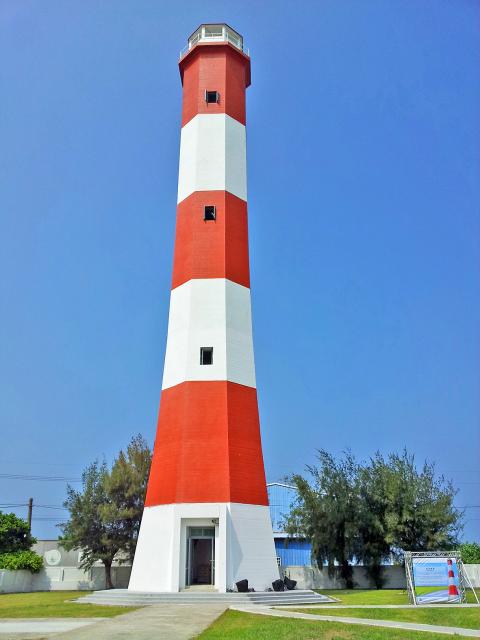The Kaomei Lighthouse (高美燈塔), on the bank of the Dajia River (大甲溪) on the northern side of the Port of Taichung, is set to become a new tourist attraction, after renovation work was recently completed by the Maritime and Port Bureau.
The lighthouse was officially opened to tourists on Saturday, becoming one of 10 lighthouses nationwide, out of 35, that are open to the public.
Previously, the lighthouses were managed by the Ministry of Foreign Affairs’ Customs Administration. The Ministry of Transportation and Communications took over the management last year, and decided to turn some of them into tourist attractions.

Photo: CNA
Built in 1967 with steel reinforced concrete, the Kaomei Lighthouse has an octagonal structure and is the only one in the country painted with red and white stripes, the bureau said.
Visitors can see the wind power generators and Kaomei Wetlands (高美濕地) from the lighthouse, the bureau added.
The lighthouse stopped operations in 1982, when the lighting equipment was moved to the top floor of Far Eastern Silo and Shipping Corp, also known as the lighthouse in the Port of Taichung, the bureau said.
The Kaomei Lighthouse continued to exist without the lighting equipment, and many people have mistaken the 34m-high lighthouse as an incinerator chimney.
According to Yeh Luen-huei’s (葉倫會) Stories of Lighthouses in Taiwan (台灣燈塔的故事), the property on which the lighthouse was located also has a fountain, which is 1.5m deep and 6m in diameter.
His research showed that the water in the fountain used to shoot up about 3m because of the strong water pressure. Children were allowed to enter the property to play baseball and swim in the fountain.
However, after the 921 Earthquake in 1999, the groundwater stopped coming out of the fountain.
Aside from the lighthouse, visitors to the site can also see a rare flower called Chinese Spiranthes, a type of orchid.
When it is blooming, the flower will wrap around the stem like a dragon, the bureau said, adding that the flowers give out a light fragrance as well.

Taiwan is to commence mass production of the Tien Kung (天弓, “Sky Bow”) III, IV and V missiles by the second quarter of this year if the legislature approves the government’s NT$1.25 trillion (US$39.78 billion) special defense budget, an official said yesterday. Commenting on condition of anonymity, a defense official with knowledge of the matter said that the advanced systems are expected to provide crucial capabilities against ballistic and cruise missiles for the proposed “T-Dome,” an advanced, multi-layered air defense network. The Tien Kung III is an air defense missile with a maximum interception altitude of 35km. The Tien Kung IV and V

The disruption of 941 flights in and out of Taiwan due to China’s large-scale military exercises was no accident, but rather the result of a “quasi-blockade” used to simulate creating the air and sea routes needed for an amphibious landing, a military expert said. The disruptions occurred on Tuesday and lasted about 10 hours as China conducted live-fire drills in the Taiwan Strait. The Civil Aviation Administration (CAA) said the exercises affected 857 international flights and 84 domestic flights, affecting more than 100,000 travelers. Su Tzu-yun (蘇紫雲), a research fellow at the government-sponsored Institute for National Defense and Security Research, said the air

Taiwan lacks effective and cost-efficient armaments to intercept rockets, making the planned “T-Dome” interception system necessary, two experts said on Tuesday. The concerns were raised after China’s military fired two waves of rockets during live-fire drills around Taiwan on Tuesday, part of two-day exercises code-named “Justice Mission 2025.” The first wave involved 17 rockets launched at 9am from Pingtan in China’s Fujian Province, according to Lieutenant General Hsieh Jih-sheng (謝日升) of the Office of the Deputy Chief of the General Staff for Intelligence at the Ministry of National Defense. Those rockets landed 70 nautical miles (129.6km) northeast of Keelung without flying over Taiwan,

A strong continental cold air mass is to bring pollutants to Taiwan from tomorrow, the Ministry of Environment said today, as it issued an “orange” air quality alert for most of the country. All of Taiwan except for Hualien and Taitung counties is to be under an “orange” air quality alert tomorrow, indicating air quality that is unhealthy for sensitive groups. In China, areas from Shandong to Shanghai have been enveloped in haze since Saturday, the ministry said in a news release. Yesterday, hourly concentrations of PM2.5 in these areas ranged from 65 to 160 micrograms per cubic meter (mg/m³), and pollutants were